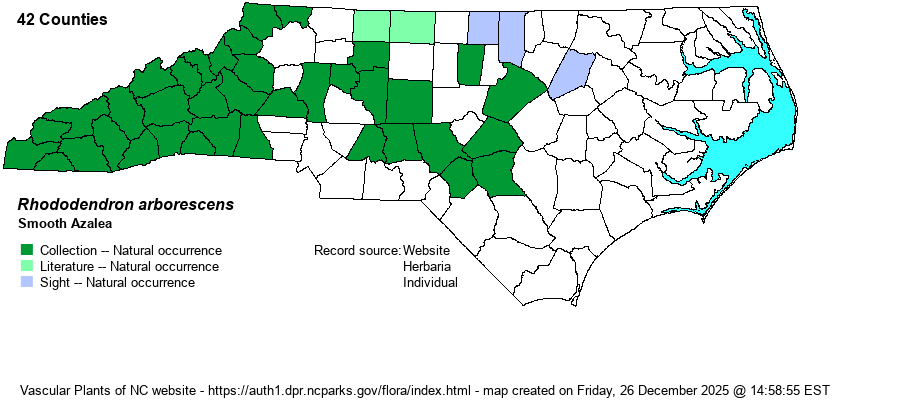| Author | (Pursh) Torrey | |
| Distribution | Occurs throughout the Mountains, and spottily through the Piedmont. Ranges eastward to the Sandhills, locally along Little River in 4 counties.
NC and TN are the center of the species’ range, as it occurs northward to PA and southward only to central GA and parts of MS. It is thus generally absent west of the greater Appalachians (i.e., is present in the Cumberland Plateau but absent farther to the west).
| |
| Abundance | Fairly common in the lower Mountains, but mostly uncommon to infrequent in the Piedmont. It is rare in the Sandhills, occurring along one small river. | |
| Habitat | Throughout most of its state range it is limited mainly to the banks and shorelines of rocky forested creeks, less so along other forested riverbanks. In the Sandhills, it occurs on indurated clay banks. It also can be found in bogs and swampy areas, mostly in the Mountains. Also, on rare occasions it occurs in heath balds and other rocky forests. Unlike many other azaleas, it seldom grows in colonies or sizable stands; often only a few plants are present. | |
| Phenology | Blooms after the leaves are fully grown, mainly from late May to July; fruits from July to October. | |
| Identification | This is a medium-sized, deciduous shrub growing mostly 5-10 feet tall, rarely to 15 feet tall. It has typical azalea leaves, being obovate (wider above the middle) and clustered on the twigs; however, this species has rather dark green and shiny leaves, almost looking evergreen. For most identifications, you need to see it in bud or bloom, as the strongly scented white flowers do not appear until well after the leaves are fully grown. A shrub with large white flowers in late spring or early summer, growing immediately along a wooded creekside, may be this species. | |
| Taxonomic Comments | Although RAB (1968) states that this species is “perhaps only subspecifically distinct” from Rhododendron viscosum, essentially no recent authorities consider this as anything but a distinct species.
| |
| Other Common Name(s) | Sweet Azalea | |
| State Rank | S4 | |
| Global Rank | G4G5 | |
| State Status | | |
| US Status | | |
| USACE-agcp | FACW link |
| USACE-emp | FAC link |

